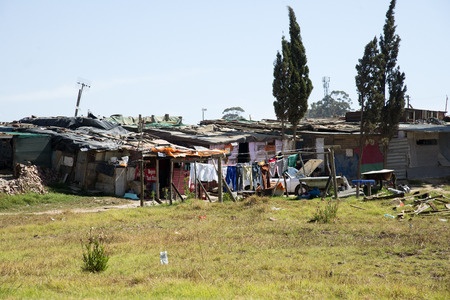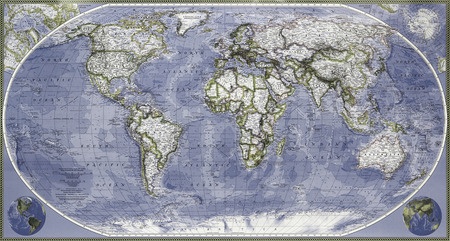Global economic growth, measured by Gross Domestic Product (GDP) per capita, has increased rapidly since the Industrial Revolution.
And yet, poverty persists.
The World Bank report Global Economic Prospects (2007) predicts that by 2030, the number of people living on less than a dollar a day will be halved, to around 550 million. However, the report points out that Africa will struggle to keep pace with the rest of the developing worldEven if conditions improve in absolute terms, Africa will have a larger share of the world's poorest people. Yet economic growth in Africa accelerated after 2000.
How can we explain this situation?
If sustainable economic growth is a necessary condition to poverty reduction (Part 1), it is not not sufficient in itself (Part 2). Complementary policies need to be implemented. Finally, Part 3 will focus on the role of the OECD in this context.
Before getting into the heart of the matter, it is appropriate to clarify the analytical framework in which this note is included.
Background and definitions
Definition of poverty
Poverty is generally considered a multidimensional phenomenonIts economic dimension is most often taken into account, and it can be broken down into four forms:
Monetary,
Living conditions (illiteracy, poor health, malnutrition, housing, etc.),
Abilities (lack of means to escape poverty),
Human poverty, measured by the UNDP HPI indices, which also take into account cultural, social, political and ethnic dimensions. Two indices exist: one for developing countries, another for OECD countries.
In the context of this note, we will focus on the material dimension of poverty, without completely isolating it from others. We cannot define an effective strategy for rapid and equitable growth without strengthening the capacities of the poor (via education and health) and reduce their vulnerability to economic shocks. L'empowerment is also partially addressed, notably through participatory approaches in the management of policies and programs.
We will therefore rely on the measurement of poverty by the HPI, and thinking about solutions (part 2) will be focused on developing countries.
Sustainable economic development
Sustainable development is generally based on three inseparable dimensions:
Economic,
Environmental,
Social.
These three pillars converge at the heart of the concept. However, this approach is the subject of debate and criticism, both from environmentalists (who question the continuity of resources) and from poor countries (who contest the pollution requirements). This note is not intended to respond to all these arguments, but to suggest avenues for analysis.
Part 1 – Sustainable economic growth: a necessary condition for poverty reduction
1.1. A strong link between growth and monetary poverty
The quality and availability of international data on income distribution and poverty have improved considerably over the past five years. These data show a strong link between GDP growth and poverty reductionConversely, stagnation or decline in GDP per capita is often accompanied by an increase in poverty.
As mentioned, global GDP per capita has increased continuously and rapidly over the past century. At the same time, poverty has declined.
For example :
The proportion of the developing world's population living on less than a dollar a day (according to the World Bank) fell from 28,000 people in 1990 to 21,000 people in 2001.
Over the period 1981-2001, this proportion was divided by two.
World Bank data also indicates a decline in all regions of the world since 1999:
| Region | 1990 | 2002 | 2004 |
|---|---|---|---|
| East Asia and the Pacific | 15,4 % | 12,3 % | 9,1 % |
| Europe and Central Asia | 3,6 % | 1,3 % | 0,95 % |
| Latin America and the Caribbean | 9,6 % | 9,1 % | 8,6 % |
| Middle East and North Africa | 2,1 % | 1,7 % | 1,5 % |
| South Asia | 35 % | 33,4 % | 30,8 % |
| Sub-Saharan Africa | 46,1 % | 42,6 % | 41,1 % |
Studies regularly conclude that there is a relationship of 1 for 1 to 1 for 4 between growth in per capita income and the reduction of monetary poverty.
1.2. A contrasting situation depending on the region
The disparities between regions are marked:
The improvement is notable in East and South AsiaIn East Asia, the poverty rate at $2 a day fell from 69,000 in 1990 to 27,000 in 2006.
In Sub-Saharan Africa, GDP per capita fell by 14% between 1981 and 2001, and extreme poverty increased from 41% to 46%, an increase from 231 to 318 million people.
Transition economies (Europe, Central Asia) experienced a severe recession in the early 1990s, followed by a gradual improvement.
Conclusion: Growth does not guarantee automatically an equitable reduction in poverty. What then are the necessary conditions for this link to work?
Part 2 – The conditions for the link between growth and poverty reduction
2.1. Analysis of macroeconomic parameters
Poverty results from multiple factors, specific to each country. There are therefore no no universal solution, and a contextual analysis is essential.
Among the main determinants of growth, we distinguish:
The investment rate (investment/GDP ratio),
Investment productivity,
Population growth (example: China),
Human capital (education, health).
According to the Harrods-Domar model, the investment rate depends on domestic and external savings, and expectations of profitability. Productivity is based on the sectoral efficiency of investments.
THE Solow-Swan model completes this approach with:
The growth of the working population,
Investment in human capital.
A well-targeted investment policy can therefore make the link between growth and poverty reduction.
2.2. The role of public policies
Numerous researches have identified the key factors for sustainable growth, linked to public policies:
Peace and political stability,
Good macroeconomic management,
Investments in education and health,
Infrastructure development,
Commercial opening (especially for export),
Reliable institutions,
Development of financial markets.
Inclusive growth must enable the poorest to:
Participate in growth,
Contribute to the economy,
To derive a direct benefit from it.
This involves:
More investment in infrastructure for local development,
Support for sustainable sectors with high social impact (rural SMEs, microfinance),
Strengthened regional cooperation,
Clear policies of redistribution (income, land, water, education, health),
Respect for ecological balances,
Real and lasting equality between men and women.
These principles come from decades of reflection and experimentation, since economists understood in the 1970s that growth was not always synonymous with poverty reduction. L'OECD plays a central role in this development.
Conclusion
Sustainable economic growth is a necessary condition, but not sufficient to sustainably reduce poverty.
Only a combination of inclusive, contextual and coordinated policies will help transform growth into human progress. Today, too many divergences between development agencies are hampering aid effectiveness. Duplication of channels, neglect of institutional costs, and lack of coordination weaken long-term results.
Only strengthened, transparent cooperation rooted in reality will make growth a real lever in the fight against poverty.


